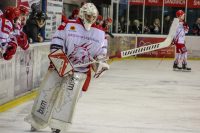PETERBOROUGH, UK – Earlier this month the EIHA announced a new structure to the leagues beneath the EIHL via a press release. Guest writer Dan Breen gives his opinions on the proposals and adds further context from EIHA Media Officer Craig Simpson.

The confirmed teams for the new second tier of UK hockey are Swindon Wildcats, Sheffield Steeldogs, Bracknell Bees, Telford Tigers, London Raiders, Hull Pirates, Basingstoke Bison and Peterborough Phantoms. These are joined by the Milton Keynes Lightning, (formerly of the EIHL), and an as yet unnamed team from Leeds to play out of the currently unfinished Elland Road Facility.
Of course, as is the norm amongst UK ice hockey fans, (and likely hockey fans the world over), this information immediately triggered a whole wave of speculation about a range of thoughts, from import levels, to budgets and caps, to who else would be applying to join the league.
Just an average day really.
On speaking to those with a bit more relevant information, I have been advised that this will not be EPL 2.0 with all of its assorted baggage and failings, and that the largest of those failings, the lack of transparent governance will be addressed from the outset and the division will be run by the National League Management Group (NLMG). Although the names of those sitting on this group are not, (at the time of writing), known at this stage, one thing is clear: The tail will not wag the dog.
Amongst the good news though, hockey fans have raised a few questions: Will there be a change in import numbers?, Will there be a salary or budget cap?. More cynically – How long until it all gets reorganised again?
One of the things that gives me quite some confidence, comes in part from the reply I received from within the EIHA regarding governance. Any new division will be run by the NLMG and will use the NIHL Rules of Competition as they are now.
That doesn’t explicitly answer either question, although it does appear to suggest an answer to both is no. No increase in imports and no budget or salary cap.
In a little more depth though, before these two popular questions can be answered, other more important questions needed to be asked first.
I passed these questions on to Craig Simpson, EIHA media officer, and received the following replies:
What is the purpose of this division, what are its overall aims?
CS: The purpose and aims are simply to have a competitive structure throughout the NIHL and a true development structure for players moving from D2 – D1 – to National, and to ensure that teams are playing at the ‘correct’ level for their standard.
 Now, those of you that have read anything I’ve written before will know that I am constantly banging the drum for player development. I won’t go too deeply into it, but it makes strong commercial sense to develop players beyond the level at which you would need them for a number of reasons – 1) the better the players, the better and more entertaining the hockey is that they play which would help to bring in better crowds, 2) While inevitably another team, most likely in a higher league, will come and tempt those players away, (this is a natural thing), it makes it easier to recruit new players if you have a track record for sending player up to bigger and better things.
Now, those of you that have read anything I’ve written before will know that I am constantly banging the drum for player development. I won’t go too deeply into it, but it makes strong commercial sense to develop players beyond the level at which you would need them for a number of reasons – 1) the better the players, the better and more entertaining the hockey is that they play which would help to bring in better crowds, 2) While inevitably another team, most likely in a higher league, will come and tempt those players away, (this is a natural thing), it makes it easier to recruit new players if you have a track record for sending player up to bigger and better things.
What plans are in place to achieve this?
CS: All divisions will be playing to NIHL rules regarding non-EIHA trained players, the NIHL is still named as a development league, and the focus is one bringing through British Trained Players.
For me, this seems to be a bit of a “we’ll suck it and see” answer. While it’s a bit short on detail, there’s a very strong possibility that with the work to create a new governance structure and single, fit for purpose, governing body for Ice Hockey, further details on confirming what format player development will take, the pathways and ensuring they adopted throughout the NIHL Divisions will logically take a backseat for the moment.
Are there any plans or strategies in place or in discussion to ensure that the new Division is and remains stable, and to minimise the inevitable impact on the current NIHL Divisions?
CS: Teams are placed in the new structure at the level that currently works for them in terms of playing standard and finance. Moves (upward) will only be looked at when teams are sustainable and have demonstrated they can survive at the higher level.
The important part here is that the levels work both competitively AND financially. There may be occasions where a team is far more successful than expected one year, however this is unlikely to mean teams forced to change divisions, up or down, if they become too successful in one division or another outside of the normal rules of competition. However, this also states that teams, should they wish to move upwards, need to show that they can sustain themselves at the new higher level. Where we have seen the de facto end of promotion and relegation in the NIHL over the past few seasons for one reason or another, this indicates to me that this is now the actual end of competition-based promotion or relegation. This won’t come as a surprise to anyone when we step back and look at recent history however, teams dropping down to find financial stability, for example. In a lot of ways, this actually appears to be a much more sensible approach, rather than expecting to enforce promotion & relegation when there are a number of second teams in the various conferences.
The Division will be run by the National League Management Group. Who are the NLMG?
CS: Currently the NLMG consists of Paul Hayes, Charles Dacres (chair of North and South), Gary Dent and Richard Carpenter (league managers). There is input to this group from areas such as officiating, discipline, registrations, fixtures, statistics etc”.
In my opinion, this is reassuring. There’s been no attempt to try bringing in untried or unfamiliar people into these roles, (although I suspect that this will happen at some point). In the meantime, as the saying goes, “If it ain’t broke, don’t try and fix it”
Are there plans or aspirations to increase the numbers of teams?
CS: Once established it is hoped that the National League is an attractive proposition for new teams in a managed structure.
 I’m inclined to call this a success before the league has already started. When the question was written, the National Division would have consisted of 8 teams, at the time of writing, it had already expended to 10. I am half expecting that by the time of publication, it may well have expanded to 12. On a serious note though, the unwritten part of this answer is that the division needs to prove itself to be stable, sustainable and free of the baggage of the EPIHL’s final days in order for this to become an attractive proposition for teams outside of the National Division.
I’m inclined to call this a success before the league has already started. When the question was written, the National Division would have consisted of 8 teams, at the time of writing, it had already expended to 10. I am half expecting that by the time of publication, it may well have expanded to 12. On a serious note though, the unwritten part of this answer is that the division needs to prove itself to be stable, sustainable and free of the baggage of the EPIHL’s final days in order for this to become an attractive proposition for teams outside of the National Division.
I did ask about import numbers. This is something that has been a hot topic on social media with a range of arguments for numbers of imports from 2 to 8.
The response from Craig to this question is very simple:
“There is no appetite from the teams in the new division to go beyond the current 2 non EIHA trained players.”
I support this whole heartedly. Having just 2 imports leaves a maximum of 20 slots available for EIHA trained players, (or those with a dispensation). Again, filling those slots does lead to competition for the known first line players – the Sam Bullas’ the Tom Norton’s and the Shaun Thompson’s – players who could, if they wanted to command a high pay day, in essence these players could become the new “imports”. Especially with 2 new teams coming into the division in the shape of Milton Keynes and the new Leeds team, who will create, simply by starting, up to 40 slots for British trained players that will need filling, either from fringe EIHL players who are bored with bench warming or looking for a sunset tour before retiring, but also from the better NIHL1 players.
This is partially a natural occurrence – players will want to play at the best level they can on a team where they get to play regular minutes. In the short term this will cause some significant pain across the NIHL in all three divisions. However, if the teams embrace player development – in the short term focused on their own needs, rather than pay lip service to it, then this will very quickly settle down and the wage demands will do likewise so long as sensible heads prevail.
There is also likely to be a further squeeze on top end players, British and imports – Brexit, (if/when it happens). On top of the likely removal of free movement and the minimal additional registration conditions for non-EIHA trained players from the EU making, there appears to be a general move towards tightening up immigration requirements in order for players to come here and play.
With the former EPIHL and NIHL being marked as development leagues, it’s virtually impossible to get a work permit for a player to come over just to play at levels below the EIHL.
 This shouldn’t affect the Elite League too badly, it should be pretty much business as usual, however it would potentially see no like for like replacements for players such as Jan Kostal, Stanislav Lascek, Ales Padelek, Michal Klejna etc, instead, a return to players able to attain a British passport – those with British parents or grand parents, mostly from North America, the scarcity of these players likely to cause a bidding war for those available, (as we saw between Romford Raiders and Peterborough Phantoms for the services of Doug McIver a few years back – a bidding war, it could be adjudged, that Romford won when they signed Josef Sladok instead).
This shouldn’t affect the Elite League too badly, it should be pretty much business as usual, however it would potentially see no like for like replacements for players such as Jan Kostal, Stanislav Lascek, Ales Padelek, Michal Klejna etc, instead, a return to players able to attain a British passport – those with British parents or grand parents, mostly from North America, the scarcity of these players likely to cause a bidding war for those available, (as we saw between Romford Raiders and Peterborough Phantoms for the services of Doug McIver a few years back – a bidding war, it could be adjudged, that Romford won when they signed Josef Sladok instead).
Again, sensible heads will need to prevail if this is not to get out of hand to the detriment of all divisions, NIHL 2, NIHL1 and the National Division
So what does this actually mean for the average UK Hockey fan?
In the short term, fans at all levels of UK ice hockey should see less uncompetitive matches which have dogged all leagues from EIHL to NIHL 2. In every league there is a team that comes first and a team that comes last – this is normal; however this will hopefully mean that no team is so far ahead or behind any team that games become dead rubber weeks before they are even played. If the aims of the EIHA and NIHL are realised then it will also mean less concern on a season by season basis about teams running into financial difficulty during the season, (or afterwards).
This stability, if it can become the long-term trend, will give a solid basis for progress, in terms of talent, commercially and with governance, all of which will support great improvement to the British game at all levels.
In time though, (I would suggest within a couple of seasons), the NIHL will need to come together to have a difficult and honest conversation, internally and with their stakeholders, as to how player development will continue, and how to do this to the benefit of all. This is something that will need support from beyond the NIHL and the EIHA – they will need the active participation of the EIHL, the GB National coaching staff and the junior sections of the EIHA.
However, as foundations go, these look pretty solid.
Dan Breen is a long time follower of the game in the UK, based in Peterborough.


You must be logged in to post a comment.